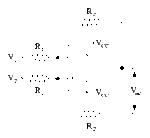KlausST
Advanced Member level 7

Hi,
I assume there is some misunderstanding at your side.
****
The TI document designs a circuit to make an output voltage from -10V ... +10V (output can be positive as well as negative = bipolar) with a DAC output voltage of 0V...2.5V (positive values only = unipolar)
The formula is: V_OUT = 8 x V_DAC - 10V
V_DAC --> V_OUT
0V --> -10V
0.5V --> -6V
1.0V --> -2V
1.5V --> +2V
2.0V --> +6V
2.5V --> +10V
If you want a +/-2V output...
= the output voltage to alternate form -2V to +2V and back --> you need to alternate the DAC_output from 1.0V to 1.5V and back.
Klaus
I assume there is some misunderstanding at your side.
This is impossible in my eyes:Can anybody show how to solve these equations to get 0 to 5V DAC voltage = +/-18V to +/-2V Output?
****
The TI document designs a circuit to make an output voltage from -10V ... +10V (output can be positive as well as negative = bipolar) with a DAC output voltage of 0V...2.5V (positive values only = unipolar)
The formula is: V_OUT = 8 x V_DAC - 10V
V_DAC --> V_OUT
0V --> -10V
0.5V --> -6V
1.0V --> -2V
1.5V --> +2V
2.0V --> +6V
2.5V --> +10V
If you want a +/-2V output...
= the output voltage to alternate form -2V to +2V and back --> you need to alternate the DAC_output from 1.0V to 1.5V and back.
Klaus











